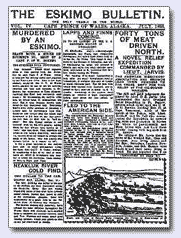Glimpses of Our Past
Glimpses of Our
Past | Alaska Stamps
The Eskimo
Bulletin was an annual newspaper published by missionary Tom Lopp in Wales, Alaska
during the 1890s and early 1900s. The 1898 issue's front page carried three stories of
significance for Alaska at the turn of the century--a gold discovery on the Seward
Peninsula, the arrival of Lapps to tend reindeer, and the story of an impressive reindeer
drive by Lopp and Native herders hundreds of miles to rescue whalers caught in the ice
near Barrow.
For more on Wales and Tom and Ellen Lopp, the missionaries who published The Eskimo Bulletin, see:
|
Eskimo Bulletin, 1898 This news story heralded the arrival of more than 100 Lapps, Finns, and Norwegians to raise reindeer in western Alaska and train Eskimos as herders. It was part of a plan by Sheldon Jackson, head of the U.S. Bureau of Education, that brought reindeer to Alaska and promoted reindeer herding by Alaska's Natives. By 1898 Lopp had worked on the Bureau's project for more than 5 years on the Seward Peninsula. He oversaw the management of the first herd of reindeer imported from Siberia and helped train the first Eskimo reindeer herders. But Lopp opposed the presence of these Scandanavians. He wrote in this issue of the Eskimo Bulletin that the plan "is much ridiculed here" and complained about "intemperate habits" among the newcomers. He trumpeted the 1898 reindeer drive to Barrow by Eskimo herders (see "40 tons of Meat Driven North") as proof of the ability of Native herders. In an editorial he wrote: "What the U.S. Bureau of Education expects to accomplish by bringing so many Laplanders to Arctic Alaska, is an enigma to all who are personally acquainted with the destitution, need, and possibilities of the Eskimo race." His criticism
of Jackson's management of the government reindeer program in the early 1900s would play a
role in Jackson's removal. Lopp would later become the Bureau's head of Alaskan
operations. During nearly 15 years as leader of the Bureau in Alaska, Lopp would greatly
expand reindeer ownership among Alaska Natives. While accomplishing this, he also
struggled to limit reindeer ownership as much as possible to Natives, a task greatly
complicated by substantial holdings by Lapp herders, some of whom later sold to the Lomen
Brothers to create the dominant reindeer company of the 1920s and early 1930s. In
retirement, though, Lopp continued to promote Native ownership, and helped to enact
legislation in the late 1930s which forbid non-Native reindeer ownership. |
